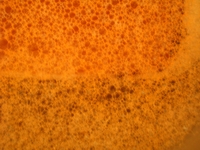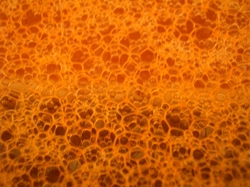IMS_Blog
Because I forget stuff. Part of norcimo.com
Note: It appears you must have reached this page by a deep level URL. In general this site is currently down and unmaintained. See here
About This Post
Originally posted November 28 2006 at 21:11 under Physics. 0 Comments. Trackbacks Disabled.
Hubble Bubble, Toil and, Er, Soap Suds
- Mood:
- For some reason, I want a lager ;-)
- Location:
- Out of the kitchen
The strange things found when soaking dishes…
The first picture shown here  is pretty much what it looks like; a bowl of soapy water in which is soaking a dish. The dish had been used in the preparation of a rather nice curry, hence the discolouration to the water. That’s not really interesting in itself—even the internet has yet to produce an obsession with the soaking remnants of people’s meals, as best I know. What was interesting was a closer look at the bubbles
is pretty much what it looks like; a bowl of soapy water in which is soaking a dish. The dish had been used in the preparation of a rather nice curry, hence the discolouration to the water. That’s not really interesting in itself—even the internet has yet to produce an obsession with the soaking remnants of people’s meals, as best I know. What was interesting was a closer look at the bubbles  . The bubbles have distinctly hexagonally shaped boundaries (I’m pretty convinced it was actually more pronounced earlier, before I decided to photograph the things). Now I do have some background in surface physics so to see hexagons in such a situation wasn’t entirely surprising but it’s still interesting to note. My memory was jogged to something I’d read the other week and a quick look through the likely places produced this piece from New Scientist’s the Last Word (New Scientist (2006) Issue 2570, page 101). Now while it’s not fully clear from the question that the bubbles in that case were hexagonal themselves I’d be surprised if they weren’t, and I’ve no doubt that similar influences are at work here (top tip: if in doubt just say “minimum energy configuration” ;-)), though the bubbles are varying enough in size that the array isn’t very regular.
. The bubbles have distinctly hexagonally shaped boundaries (I’m pretty convinced it was actually more pronounced earlier, before I decided to photograph the things). Now I do have some background in surface physics so to see hexagons in such a situation wasn’t entirely surprising but it’s still interesting to note. My memory was jogged to something I’d read the other week and a quick look through the likely places produced this piece from New Scientist’s the Last Word (New Scientist (2006) Issue 2570, page 101). Now while it’s not fully clear from the question that the bubbles in that case were hexagonal themselves I’d be surprised if they weren’t, and I’ve no doubt that similar influences are at work here (top tip: if in doubt just say “minimum energy configuration” ;-)), though the bubbles are varying enough in size that the array isn’t very regular.
One further interesting point was that the phenomenon seemed only to come about thanks to the curry. Near the edge of the bowl, where the curry had yet to spread (dispersal rate of curry remnants from a soaking dish is probably a study with commercial implications in itself!), though it’s not very clear in this photo  the “pure” soapy water didn’t exhibit the hexagonal bubbles/array anywhere near as clearly. Whilst the edge of the bowl may have been having an effect it seemed to spread far enough in that I certainly got the impression that curry was required, with a messy interface as the curry concentration dropped.
the “pure” soapy water didn’t exhibit the hexagonal bubbles/array anywhere near as clearly. Whilst the edge of the bowl may have been having an effect it seemed to spread far enough in that I certainly got the impression that curry was required, with a messy interface as the curry concentration dropped.
Finally, it seemed that the system was just one “layer” deep. There certainly seemed to be arrays of bubbles beneath the bubbles. A bubble hexagonal crystal anyone… 
As a sort of aside, the afore mentioned New Scientist piece garnered a response (New Scientist (2006) Issue 2574, page 93). It tells how Lawrence Bragg and John Nye used soap bubbles to investigate metallic crystals. Typical!! All this research just to find somebody has published already! ;-) I did try popping the bubbles next morning, when there was only a sparse surface layer remaining in small patches. Pretty interesting to watch the lattice close up around the “vacancy” produced.
In case anyone actually is interested, I’ve uploaded a few more pics and the full, full size versions of the one here, into a photo album
Comments (0):
Post a comment
Name and email address are required. Email address is never shown. If you enter a URL your name will be linked to it (this and other links will have the rel attribute set to contain nofollow). Markup allowed: <a href="" title="" rel=""> <em> <strong> <abbr title=""> <acronym title=""> <p> <br />. Anything else is stripped; please be valid. Single linebreaks automatically convert to <br />, double to <p>'s. Additionally anything that looks like a bare URL should get automagically linked. Many acronyms and abbreviations are also automagically handled.
Please note this blog's comment policy
Trackbacks (0):
Trackback URL: http://www.norcimo.com/MT/mt-tb.cgi/631
© Ian Scott. Powered by Movable Type 3.2. This blog uses valid XHTML 1.0 Strict and valid CSS. All times are local UK time. For further details see the IMS_Blog about page.. All my feeds in one.

